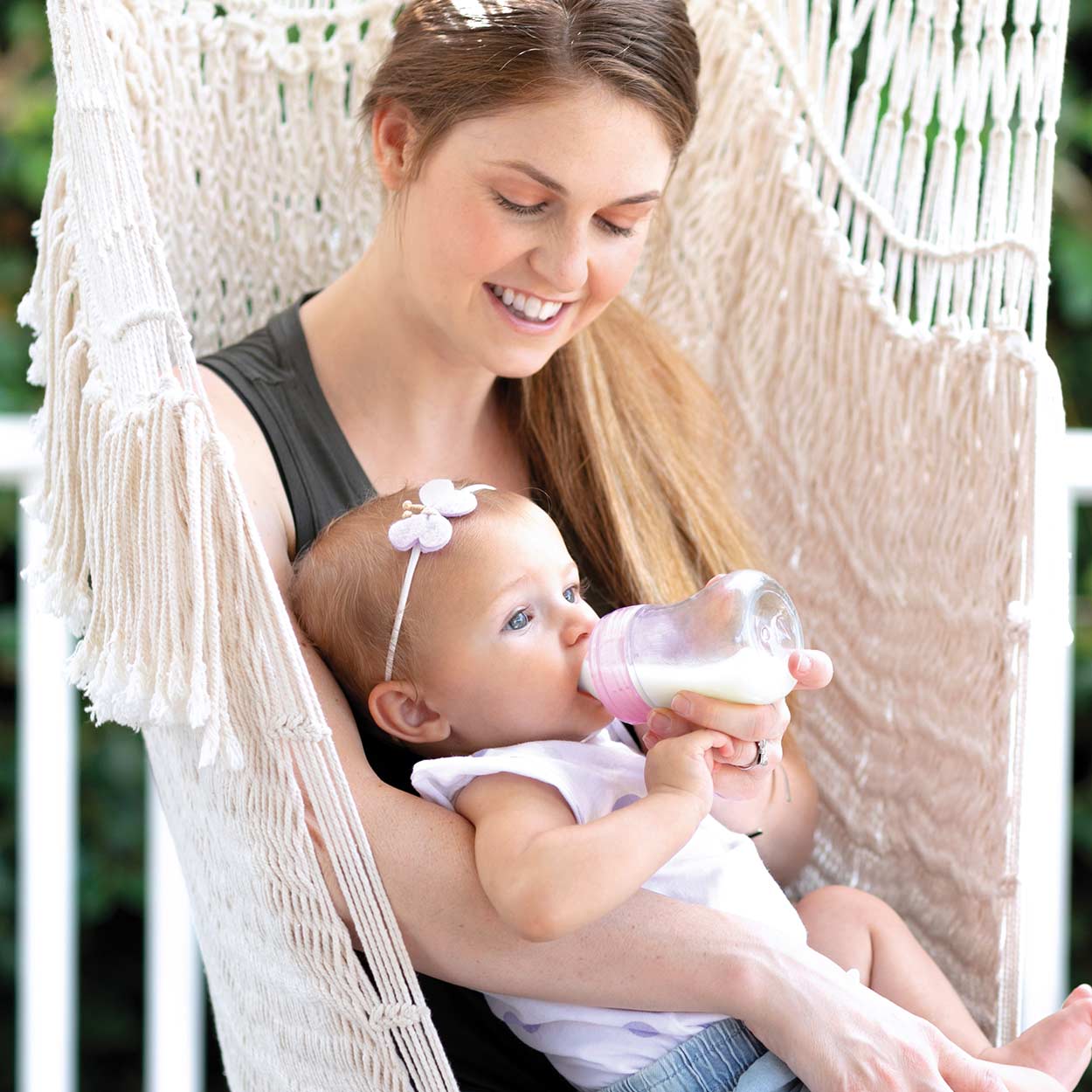
Whether you're offering pumped breast milk or formula, adopting paced-bottle feeding is a way to ensure that your baby gets the nutrition they need, while also developing a healthy feeding pattern. With paced feeding, your baby sets the pace, meaning they control how much milk flows from the bottle using their tongue and lips. The result is a slower, more thoughtful mealtime for your little one. The goal is to mimic how they would feed if they were breastfeeding, so they can take control of the pace and size of their meal.
Traditional bottle feeding often results in babies gulping down milk too quickly, leading to gas and overeating, while aggravating painful conditions like colic (also called reflux). Much like breastfeeding, paced feeding is slower than traditional bottle feeding and requires your baby to work a little harder for their meal. The idea is to allow your little one's brain time to catch up with their stomach, giving them time to realize they've had their fill well before they overdo it.
Looking to add the convenience of bottle feeding to your routine but still plan to breastfeed? In that case, paced feeding is ideal because, due to the similarities, it can help your baby go back and forth between the two without much difficulty. Paced bottle feeding is also a good solution for parents who use formula or wish to phase out breastfeeding while encouraging healthy eating habits in their little ones.
The Benefits:
- Reduces the likelihood of over or underfeeding- Both you and your baby learn to understand and trust their hunger cues.
- Lowers risk of choking or ear infections- Paced feeding positions your baby upright or semi-upright, reducing the risk of milk or formula going down the wrong pipe or finding its way into their eustachian tubes (inner ear), causing infection.
- Cuts down on reflux and stomach pain- Paced feeding reduces the risk of overfeeding and air intake during mealtimes, lessening the chances of painful gas and the effects of reflux.
- Prevents Nipple Confusion- Because paced feeding mimics breastfeeding in many ways, it makes nipple confusion less likely. "Nipple confusion" is when a breastfeeding baby experiences issues with latching and breastfeeding after the introduction of bottle feeding. The term is a bit misleading because your baby isn't actually confused; they've just developed a preference for one feeding method.
If you want to try paced bottle feeding, there are only a few things you'll need to get started. First, you'll need a good quality glass, BPA, PVC, and Phthalate free plastic bottle. If you want the best of both worlds, check out our Duo Hybrid Bottle. It’s the first-of-its-kind baby bottle that permanently bonds a micro-thin layer of unbreakable INVINCI-GLASS® to the inside of a premium plastic bottle, making it break-proof yet lightweight.
You'll also need a paced bottle feeding nipple to help control the milk flow. Starting out, you might need to experiment with a few different nipple shapes to see what works best for your baby. Wondering where to start? Our INTUI-LATCH nipple features an anti-colic valve that vents air away from the nipple and is shaped to position your baby's lips and tongue for an easy latch.
Once you've got the above covered, all you need is some breast milk or formula, a burp cloth, and a comfy spot for you and your baby.
Now that you know what paced-bottle feeding is and have all the supplies you need, it's time to learn how. Burp your baby frequently as you follow the steps below.
- Find a comfortable spot for both you and your little one. Paced feeding sessions can easily take 20-30 minutes.
- Make sure your baby is comfortably upright with their head and neck well supported.
- Gently touch your baby's mouth with the nipple (as you would when beginning breastfeeding) to stimulate their rooting reflex.
- Gently advance the nipple into your baby's open mouth.
- Once your baby has latched on, allow them to set the pace. After 20-30 seconds, briefly tip the bottle back to interrupt the milk flow. If your baby starts to swallow too quickly, pull the bottle away for a moment and resist the urge to help them eat faster.
- Switch sides halfway through the feeding; this further mimics breastfeeding and gives your baby a fresh viewpoint.
- When your baby shows signs of being full (like turning their head away or slowing down), it's time to end the feeding session.
Paced feeding is about tuning in with your baby. By learning how to interpret your baby's feeding cues, you understand when they want more or less milk or are finished feeding. This way, eliminate mealtime guesswork and create a calm and relaxed feeding experience for both of you.
Paced bottle feeding mimics the pace and relaxed experience of breastfeeding and, like breastfeeding, allows your baby more control over their mealtime than traditional bottle feeding. In addition, it reduces the risk of overfeeding, gas, and reflux and helps prevent nipple confusion for breastfeeding babies.
If you want to try paced bottle feeding, you only need a paced nipple, a good quality bottle, and a little patience. The best part? Paced feeding is a quiet bonding time for you and your baby to look forward to. By taking the time to pace bottle feed your baby and learning their feeding cues, you're creating a calm, nurturing environment where they can learn to eat when they're hungry and stop when they're full, setting them up for a healthy lifelong relationship with food. Happy feeding!
Check out our blog for more guides and parenting tips.
